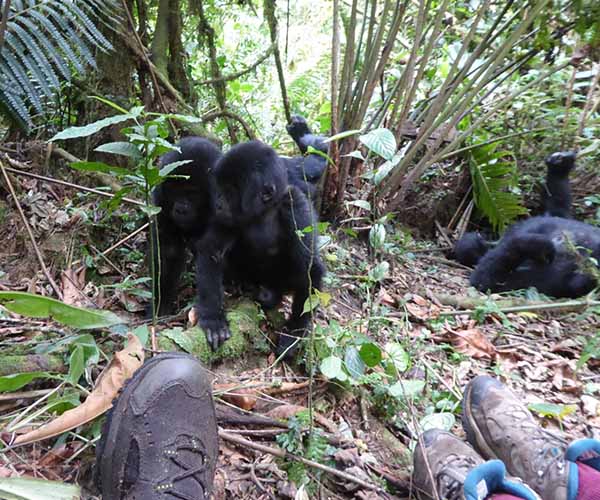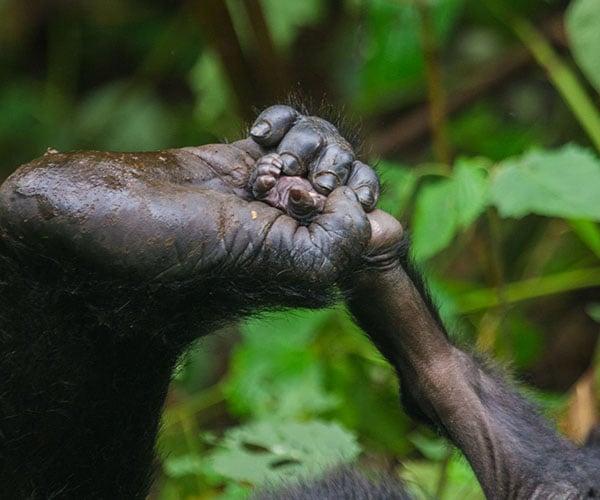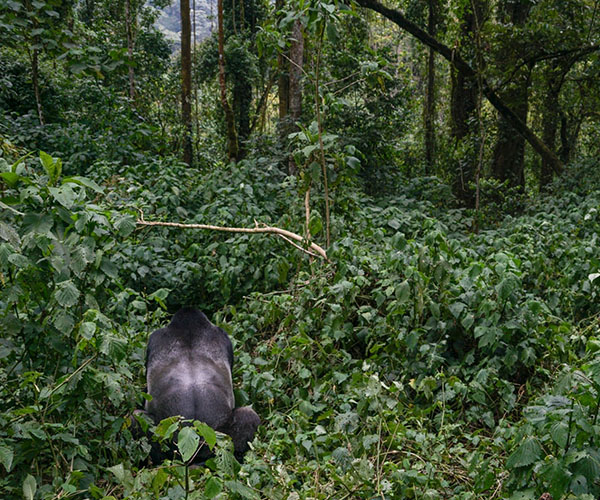Other than the ordinary gorilla trekking that allows visitors an hour with a habituated gorilla group, Uganda also offers the gorilla habituation experience, which gives visitors an opportunity to spend four hours with a gorilla group still under delicate observation. The habituation experience only happens in Uganda’s Bwindi Impenetrable Forest, and visitors that have had the chance to take it rate it as more immersive and captivating than the ordinary one-hour with the mountain giants.

Gorilla habituation experiences occur only in Bwindi Impenetrable National Park, a 321 km2 high-altitude Afromontane forest in southwestern Uganda listed as a UNESCO World Heritage Site. The park has steep and high hills and rich biodiversity, including the largest population of mountain gorillas, chimpanzees, a variety of monkeys, birds, duikers, and elephants, all living amidst various species of insects, plants, and micro-organisms.
What is the gorilla habituation?
Gorilla habituation is a process by which humans (primatologists working with their assistants and forest rangers) gradually make peaceful contact with a wild gorilla group in their natural environment until the gorillas regard human visits as harmless to their existence. The process can take about 2-5 years, depending on how the wild gorillas are receptive to human presence.
Mountain gorillas that have not gone through the Habituation Process live far from human settlements. They are shy, will scamper deeper into the thickets when approached, and could be dangerous when startled. Although many unhabituated gorilla groups exist in the mountain forests of Uganda, Rwanda, and DRC, a few have been through the Habituation process and are available for tourism.
44 habituated mountain gorilla groups are available for tourism across Uganda, Rwanda, and the DRC. Uganda alone has 20 habituated gorilla groups and more than half of the total population. Habituated groups range in size, with an average of 10 family members, but some can have as many as 40 individuals.
History of gorilla habituation
Gorilla habituation by scientists started in Rwanda after German colonial army Captain Von Beringe and, later, other Western scientists (Louis Leakey, George Schaller, and Dian Fossey) ‘discovered’ the mountain gorilla. Notably, Dian Fossey camped in the forests of Rwanda and recruited other conservationists and local residents to ‘make friends with the gorillas,’ eventually habituating them to human presence.
Dian Fossey’s work pioneered gorilla habituation, identification, tracking, range mapping, and other primate research techniques used by gorilla conservationists today. However, she soon realised that if the gorillas were to survive, they would also require protection from threats like poachers who set snares in the forest, cattle grazing, and human encroachment into the forest.

Fossey then organised weekly anti-poaching patrols to protect the gorillas, later making important discoveries about gorilla ecology, behaviour, and more. Her methods of protecting and monitoring mountain gorillas later became valuable tools for research and conservation programs for the great apes and are widely used by conservationists across the gorilla ranges in tropical Africa.
Introducing the gorilla habituation experience
In 2015, the Uganda Wildlife Authority (UWA) introduced the gorilla habituation experience to paying visitors in Bwindi Impenetrable National Park—the first of its kind for tourism with gorillas in Africa. In addition to being a significant source of gorilla conservation funds, the experience also helps the researchers monitor how the gorillas respond to different tourists.
By the time the researchers allow tourists to join in the habituation process, the gorillas would have calmed enough to allow rangers, doctors, and primatologists to come as close as 15 meters to observe and photograph them. The gorillas would consider tourists welcome for a comfortable period. The gorilla habituation experience lasts for 4 hours (3 hours more than the ordinary and cheaper gorilla trekking excursion), starting very early in the misty morning before sunrise to find the gorilla group before they trek far from their nightly nests.
To join the half-day experience, one has to book a gorilla habituation permit for USD 1500 per head. UWA offers only 4 permits per gorilla group, and currently, only two gorilla groups are available for the experience (Posho Gorilla Group in Nkuringo and Bikingi Gorilla Group in Rushaga Sector). However, by the time of writing this, Posho was not officially available for permit booking, but the permits for the Bikingi Gorilla Group were available.
A typical gorilla habituation experience tour package
A typical gorilla habituation experience trip will begin from Entebbe (the entry city to Uganda), where visitors will most probably spend a night and take a scheduled domestic flight to Kisoro, a 1.5-hour drive outside Bwindi Impenetrable National Park.
If visitors want to enjoy the countryside, they can alternatively take the 10 to 11-hour-long drive across the beautiful hills and scattered towns to reach the gorilla park on the Ugandan southwestern border with Rwanda and DRC.
Either way, they will spend a night in the mountains near the trekking centre to join the early morning experience the following day. A good number of budget to luxury safari lodges sit on ridges around the trekking centres in Nkuringo and Rushaga Sectors; one wouldn’t fail to get where to stay with a decent meal.
Most travellers include the ordinary gorilla trekking experience after the habituation experience to get both adventures, meaning they will spend another night or two at the edge of the gorilla park. Although gorilla trekking is equally captivating and physically demanding, the habituation experience is more immersive. Because of the four hours one has with the gorillas, the experience offers a greater opportunity to understand the lives of gorillas and capture better photos of mountain gorillas in their natural habitat.
After the gorilla experience, some visitors usually catch a flight back to Entebbe or join the western Uganda wildlife safari circuit up north of Bwindi Impenetrable National Park. Prominent attractions on the Uganda safari circuit include driving through Ishasha Sector to catch sight of the magnificent tree-climbing lions and a boat safari on the Kazinga Channel to see animals on the channel’s banks, such as elephants, hippos, buffalo, Nile crocodiles, and several bird species. Visitors extending their trip to Queen Elizabeth National Park would require at least a day to transfer from Bwindi by road. However, they can take a one-hour scheduled flight between Kisoro (Bwindi) and Mweya or Kasese Airports, located a few minutes outside the park.

Beyond the safari in Queen Elizabeth, most visitors drive about 3 hours to Kibale National Park and explore the chimps empires at the base of the Rwenzori Mountains. Kibale Forest has a high concentration of primates, with up to 13 primate species protected within the park, including our famous cousin chimpanzee troops. With a few chimp troops habituated for tourism and research, Kibale offers top-rated chimpanzee trekking and habituation experiences. Chimpanzee Habituation Experience in Kibale is similar to the gorilla one, the permit is way cheaper at USD 250 per person, and the experience is on a flat forest floor, making it more manageable. Visitors spend a night or two outside the park and join the early morning excursion. From Kibale, it is about a 5-hour drive back to Entebbe.
A few tips before you go
The Gorilla habituation experience occurs only in Bwindi Impenetrable National Park in the southern sectors, at high altitudes of up to 3000 meters. It happens in physically demanding, uneven, slippery, muddy terrain, requiring that you prepare yourself physically and emotionally before you go. It’s a rainforest out there, so know it can rain anytime.Pack clothes that will befit the cold and wet weather since you will be trekking in the rainforest mountains. Carry a poncho or light rain jacket, waterproof hiking shoes and backpack to carry your lunch pack and gear, a long-sleeved shirt, and lightweight trousers.
IMPORTANT NOTICE:
If you are reading this article anywhere other than on A Luxury Travel Blog, then the chances are that this content has been stolen without permission.
Please make a note of the web address above and contact A Luxury Travel Blog to advise them of this issue.
Thank you for your help in combatting content theft.
It is best to go in the dry seasons of June to Sept or Dec to Feb when the weather is dryer and comfortable for trekking in the rainforest. However, you must note that the dry seasons are also peak, meaning there is a high tourist demand for permits and descent accommodation. So book early—at least six months in advance.For an immersive experience of the gorilla region, spare at least three nights outside Bwindi Impenetrable National Park. Remember, the first night for arrival, the second after the experience, and maybe the third to explore the region. Bwindi offers other immersive day adventures away from mountain gorillas, such as nature walking trails across the forest, cultural encounters with the native Batwa forest tribe, some of the most rewarding birdwatching expeditions in Africa, and sustainable community walks.
Book a packaged trip with a licensed tour operator to avoid logistical and transfer nightmares. Most licensed operators will book the permits, find suitable accommodation to match the trekking permit location, including meals and arrange transportation in a 4×4 car with an English-speaking driver guide in the trip quote. Verify a tour operator at the Uganda Tour Operator (AUTO) website or Uganda Tourism Board (UTB) website.
Go for the gorilla habituation experience in Bwindi; it’s worth it!
Lydia Eva Mpanga is CEO & Founder of Nkuringo Safaris. Nkuringo Safaris has been in business since 2007, offering bespoke sustainable, innovative, private wildlife safaris in Uganda and Rwanda.
If you would like to be a guest blogger on A Luxury Travel Blog in order to raise your profile, please contact us.


